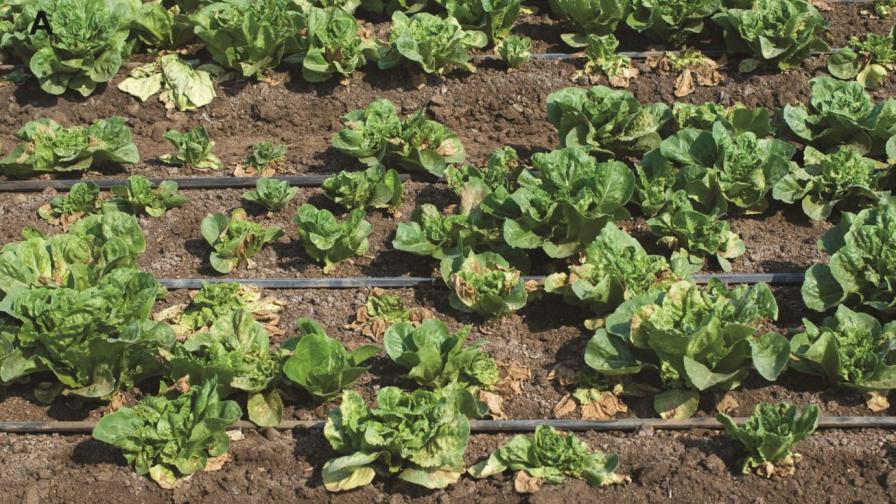Take a Whole Systems Approach To Growing Your Vegetable Crops
A whole systems approach in a vegetable system encompasses a broad definition.
But I want to keep it focused on:
• Improving soil and plant health
• Increasing biodiversity, both above and below ground
• Incorporating a sound and validated IPM program within a system
• Creating a system that documents the changes and improvements for future generations
Let’s look at the components to a healthy soil, then figure out how to build on that to achieve a whole systems approach to controlling production issues.
What Is an Ideal Healthy Soil?
There are three major components to a healthy soil: the physical, chemical, and biological.
Think of the physical aspects of soil like your own house. You need space to move around and the ability to restock the fridge with healthy food.
So, an example of healthy soil would look like this:
• 45% sand, silt, and clay (cation exchange capacity — CEC — of 15 to 35)
• 25% air
• 25% water
• 5% organic matter, which is the food source for microbes.
The chemical aspect refers to the minerals available to the plant (such as potassium, manganese, calcium, etc.) and the pH. Track nutrients, how much you have, and how much is available.
And then there is the biological. It depends on the physical chemical to survive and thrive. In healthy soil, a single teaspoon includes more micro-organisms than there are people on Earth.
The roles of microbes include but are not limited to mineralizers, decomposers, pathogen suppressors, and plant stimulants. If we could build more biodiversity and biomass of microorganisms in the soil, then the soil could be more resilient to adverse conditions.

This is what some romaine and iceberg lettuce fields in the Salinas Valley looked like at the end of the season this last year and in 2020, and some were a complete loss from INSV and pythium.
Photo courtesy of USDA-ARS
How to Use the Whole Systems Approach
Once you’ve built healthy soil, how do you use the whole systems approach to battle a problem pest or condition?
Let’s look at an example I’m familiar with.
Here in the Salinas Valley, Western flower thrips/INSV (impatiens necrotic spot virus)/Pythium unicilatum complex is rampant and a major cause of crop loss over the last couple of years in lettuce.
Thrips are a vector for INSV. And when crops are stressed, as they are when carrying a virus load, their resistance plummets. That makes them vulnerable to fungi like pythium. It’s a cascade effect.
If you can reduce thrip populations, you help reduce INSV and pythium as well. Although it shouldn’t be your sole focus. The more you can eliminate other stresses on crops, the more resistant they’ll be to pythium. Under most circumstances, the crop can withstand some load of fungi in the soil, but once the crop is in a weakened state from some external factor, like a virus, insect, or temperature extreme, then a crop can become more susceptible to fungal attack.
Unfortunately, there’s no eliminating thrips at this point. Just about every native weed in California is a host plant for the pest. Also, when we use broad-spectrum chemistries, we are killing everything. Then what’s the first thing to re-populate? The pests.
So, the goal is to reduce numbers and, therefore, increase the chances of a field escaping infection. This is where you must look at the whole system.
Consider All Aspects for Control
What are some methods to control this or prevent it from happening again?
Can we fill the niches of soil microbial populations with the good guys? Can we increase soil health so the crop can put up a defense mechanism to these pathogens?
How do we reduce thrip populations? Perhaps by encouraging natural insect predators to overwinter near or in the fields. That will allow them to get an early start on thrip populations.
You can do that by installing insectary plant strips. These include host plants for native beneficials. And if they’re flowering hosts, these strips can also help support pollinators as a side benefit. On the flip side, eliminate INSV host weeds, reducing the overall load of the virus in the environment.
Another strategy is to release thrip predators like orius, cucumeris, or swirski mites in February and March to help out native predators in consuming thrips, their eggs, and larvae.
Maintain plant health by feeding the crop with precision fertilizer applications — both soil and foliar — so not to over or under feed your crop.










